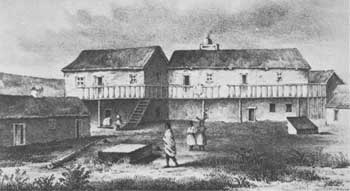





Survey of Historic Sites and Buildings
 |
FORT HALL [Fur Trading Post] Idaho |
 |
| ||
The Fort Hall fur trading post, not to be confused with the later Army fort of the same name at a different location, was particularly noteworthy in the history of the fur trade, transportation-communications, and overland emigration. Its significance in these fields is discussed in detail in the appropriate volumes of this series. The fur trading post, however, also had associations with military-Indian affairs.
The post was founded by Nathaniel J. Wyeth, an opportunistic New England businessman who dreamed of exploiting the natural resources of the Oregon country. After an exploratory expedition there in 1832-33, he returned the next year. Near the confluence of the Snake and Portneuf Rivers in southeastern Idaho, he built Fort Hall, a stockade of cottonwood logs with two blockhouses. But he found he could not compete with the powerful Hudson's Bay Co., which the same year built a rival post, Old Fort Boise (Snake Fort), Idaho, 260 miles to the west at the confluence of the Boise and Snake Rivers.
Around 1837 the Hudson's Bay Co. purchased Fort Hall from Wyeth, reconstructed it with adobe, and enlarged it considerably. It became a center of the Rocky Mountain fur trade and was such a lucrative enterprise that the Hudson's Bay Co. maintained it until approximately 1856, or a decade after the United States acquired full rights to the Oregon country from Great Britain. The post served an acculturative role among the intermountain tribes similar to that of Fort Union Trading Post, N. Dak., Fort Laramie, Wyo., and Bent's Old Fort, Colo., among the Plains Indians.
 |
| Interior view of Fort Hall trading post, in 1849. (National Archives) |
Occupying a prime location only 50 miles northeast of the point where the Oregon-California Trail forked to Oregon and California, Fort Hall in 1842-43 became a major way station and supply point for emigrants and travelers. Dr. Marcus Whitman, Rev. Henry H. Spalding, and Father Pierre Jean De Smet stopped there at various times. So did the explorer John C. Fremont in 1843, while probing the Far West. He recommended establishment of a permanent military post at the spot to supply emigrants and protect them from the Indians. The Army never acted on his proposal, but troops later frequently camped at the fur post site or its vicinity.
In 1849 the Loring Expedition of Mounted Riflemen from Fort Leavenworth, Kans., establishing posts along the Oregon Trail, founded Cantonment Loring, often incorrectly known as Fort Hall, apparently 3 miles up the Snake River from the fur trading post. Loring left two companies to erect a permanent post and proceeded to Fort Vancouver, Wash. A shortage of forage and provisions, however, caused the abandonment of the cantonment the next May.
A decline in trade and increasing Indian hostilities led the Hudson's Bay Co. to discontinue operations at Fort Hall sometime around 1856. For a few years itinerant traders sometimes lived in the crumbling buildings. In 1859-60 and 1863 Regulars and Oregon Volunteers camped there while patrolling the trail. A flood in the latter year destroyed much of the fort. During the 1860's and 1870's overland stage and mail lines used the site, a key road junction, as a base. So, too, did freighters hauling supplies to mining camps in Oregon, Washington, Idaho, and Montana.
In 1865-66, slightly to the north of the Fort Hall site, Oregon Volunteers protecting the Oregon Trail maintained temporary Camp Lander. For materials, they may have utilized log and adobe scraps from the old fort. Federal troops returned to the area in 1870, but they established a new post, also named Fort Hall, 25 miles to the northeast.
The fur post site is on the Fort Hall Indian Reservation. A small monument stands about 50 yards from the edge of American Falls Reservoir. The only surface remains are low earth mounds outlining the fort's walls. Except for the waters of the reservoir, the natural scene is relatively unchanged. The sites of the nearby posts of Cantonment Loring and Camp Lander, often confused with Fort Hall, have not been ascertained.
NHL Designation: 01/20/61
 |
 |
http://www.cr.nps.gov/history/online_books/soldier-brave/siteb4.htm
Last Updated: 19-Aug-2005